The Kullaberg Nature Reserve Youth+ Experience
In the summer of 2022, Kullaberg Nature Reserve invited two groups of Youth+ to stay, work, learn and share their experiences over the course of two three-week periods. These 9 young people came from Austria, Estonia, Italy, Latvia, the Netherlands, Slovenia, Spain and Switzerland – a very international EUROPARC experience!
Article issued by Moritz Mairl
The Kullaberg Nature Reserve Youth+ Experience
Kullaberg Nature Reserve is located on a peninsula in southern Sweden. and is one of the most visited protected areas in Sweden thanks to its unique landscape, rich biodiversity, and cultural history. Over the course of 3 weeks, the two groups of Youth+ were involved in many different aspects of Protected Area management, incorporating all the four pillars of the Youth+ programme into their work: Nature Conservation, Communication, Leadership and Advocacy.
Nature conservation and recreational space are very close to each other in the area. Visitor management therefore plays a very important role in the Protected Area management. Both Youth+ groups spent many days in the sun, rain and wind, collecting visitor surveys which are used to gather important information about possible conflict points between nature conservation and tourist recreation. These data will be incorporated into a long-term visitor management program. Visitor management also included practical work. For example, we extended a hiking trail with wooden planks to keep visitors on the trail and to protect the vegetation.
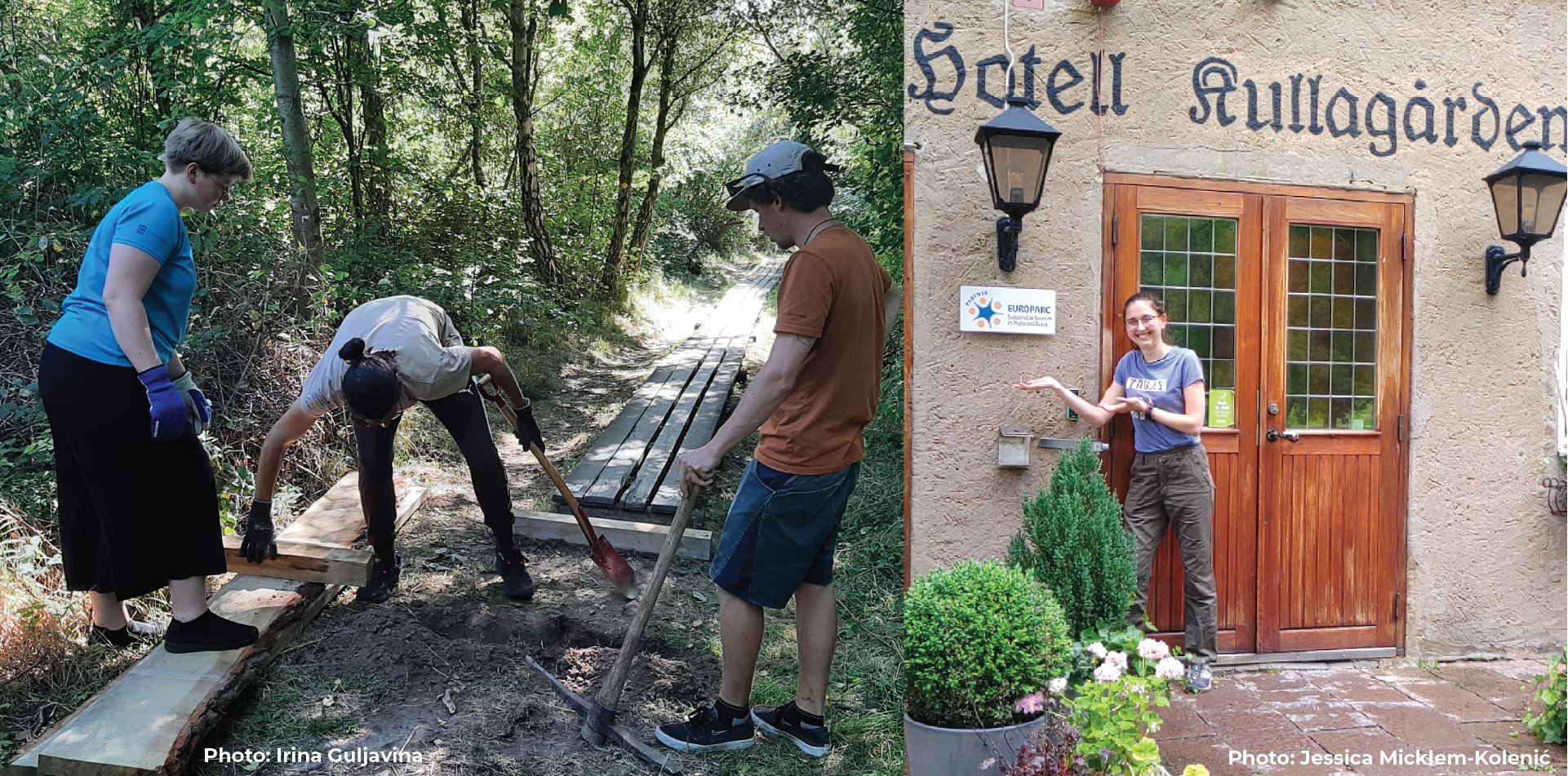
The Youth+ group assisting with trail building and with surveys for the European Charter for Sustainable Tourism
The history of the Nature Reserve is marked by tourism and cultural landscapes. Our meetings with local actors were very informative and brought the history of the region to life. And what better way to talk about the beginnings of the bathing culture in Mölle than during a classic fika (a traditional Swedish coffee and cake break). In the future, the local community plan to be even more involved with the European Charter of Sustainable Tourism, a great way for local businesses and the park to facilitate long-term sustainable development in and around the Protected Area.
While meeting with a local farmer, on the other hand, there was no time for a fika. Sheep had to be unloaded, and the cultural landscape that has been maintained for centuries should continue to be preserved. Even if the work is now only financially viable through subsidies, the cultural heritage is preserved and by working with old native breeds of sheep and cows, the farmer contributes to the promotion of biodiversity. A work that should receive far more recognition and access to financial support.
Nature is also changing in Sweden. Invasive species threaten the native flora and fauna. To curb the problem, the Youth+ assisted with both tangible actions (uprooting invasive plants) and education of the local community and tourists. At the same time, new habitat have been created for rare native species. Due to a lack of deadwood in the forest, bats find it difficult to find enough nesting holes. To counteract this problem, the International Youth+, the local Youth+ and the Kullaberg Junior Rangers have been building some bat houses and installed them in the forest. We hope for numerous inhabitants!
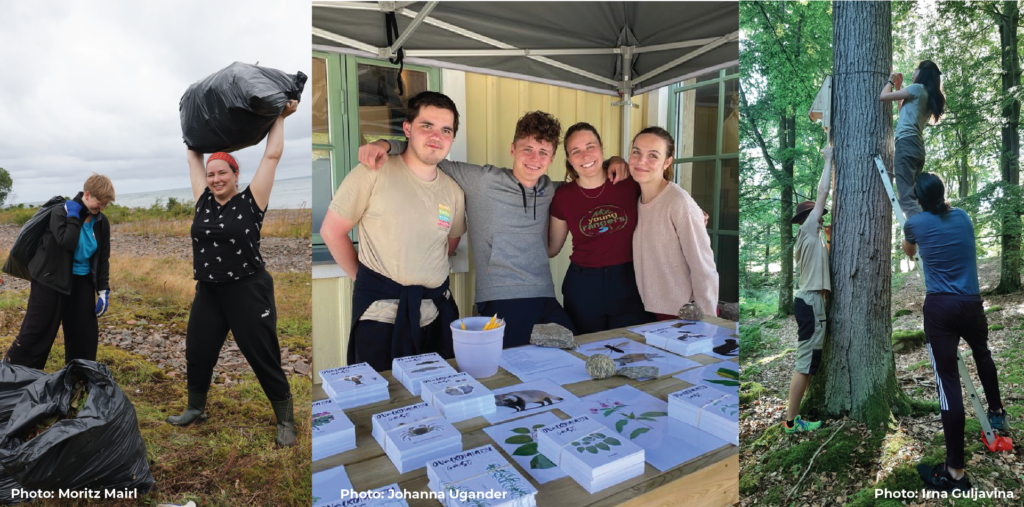
The Youth+ eradicated invasive species, helped raise awareness about their danger to local species, and put up bat houses for conservation.
The Kattegat Strait between Denmark and Sweden is one of the busiest shipping routes in the world. This became very clear when looking out from the lighthouse, the landmark of the nature reserve. Nevertheless, many sea creatures feel extremely comfortable around the peninsula. Lessons about the marine and shoreline life in the area allowed the Youth+ to better understand the biodiversity of the region and experience it first-hand, whether in the Naturum (the visitor centre), while snorkeling or during a Porpoise Safari. Even garbage collecting became an exciting job when you can search for garbage in a kayak or boat along the impressive cliffs!
The Kullaberg Nature Reserve offers enormous diversity in a relatively small area. The participants, each of whom has already gained experience in Protected Areas in their home countries, appreciated this. But what about the young people in the region around the nature reserve? This question was explored in a design thinking workshop.
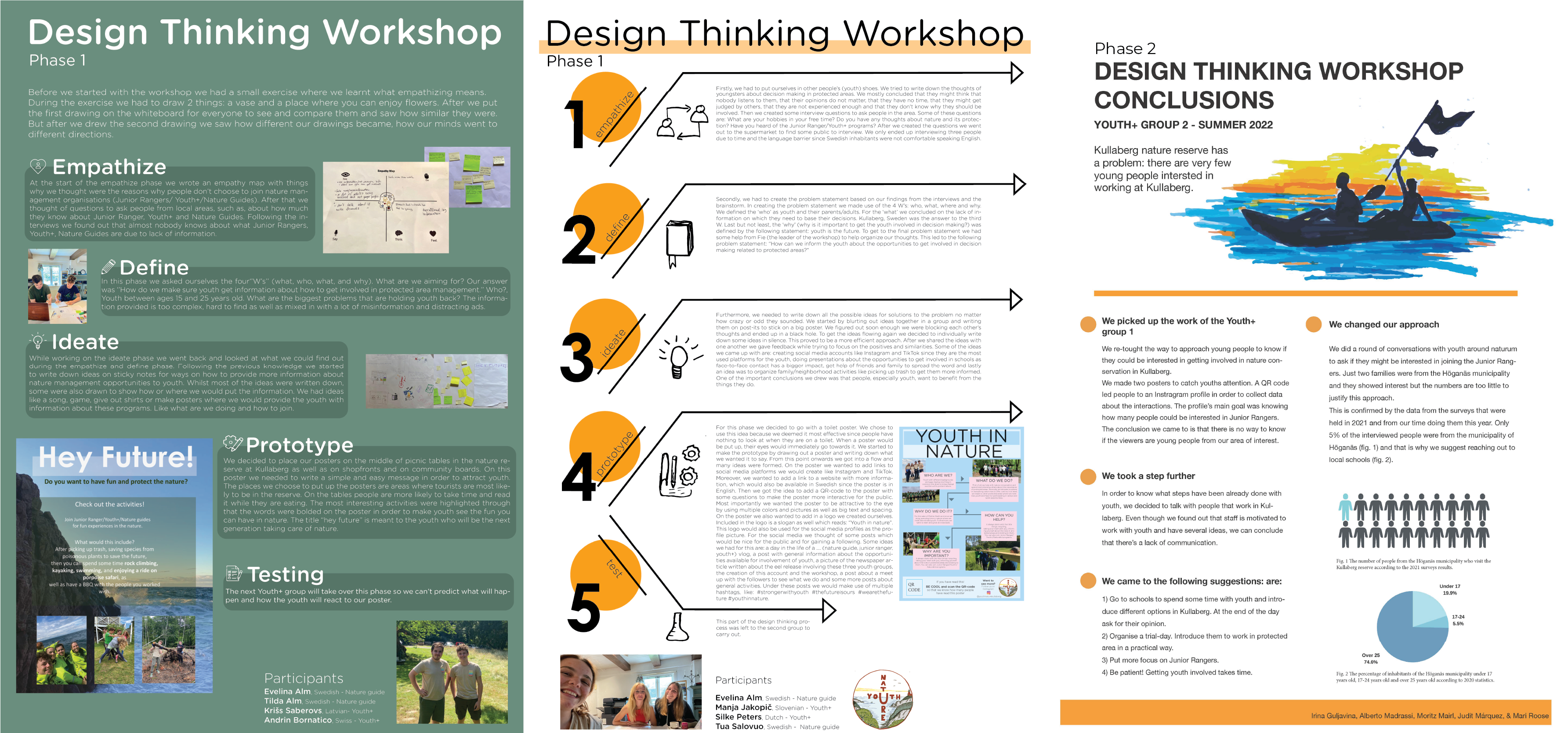
The three posters explaining the Design Thinking Process of Groups 1A, Group 1B (both doing Phase 1) and Group 2 (doing Phase 2)
You can download them here:
Group 1A: Process & Poster
Group 1B: Process & Poster
Group 2: Process & Poster
The Youth+ groups worked together with the local Naturvärdar (a local seasonal youth workers in Kullaberg Nature Reserve), following the design thinking process to evaluate how the Protected area could engage more young people. The first group of Youth+ started the process by interviewing local teenagers and young adults. As a group, problems were recorded, new solution-focused strategies were developed and tested. Posters were used to make young people in the nature preserve aware of what opportunities exist for participation. Interactions with the posters were then tracked on social media using QR codes. The results were evaluated together. Design thinking is a non-linear process that involves setbacks and many questions. For example, the poor interaction with the posters led to some frustration, but also to the development of new solutions and strategies.
The second Youth+ group then continued the design-thinking process to look at how young people can be better reached and what it takes to keep them involved in the park’s work. As an outcome of the workshop, posters and scripts were developed, which present strengths, weaknesses and possible courses of action for Kullaberg Nature Reserve. This should help the management of the reserve to be more active in the field of youth work in the future. Since Kullaberg Nature Reserve is considered the flagship for EUROPARC youth programs in Sweden, in the best case this can have an impact on the whole country!
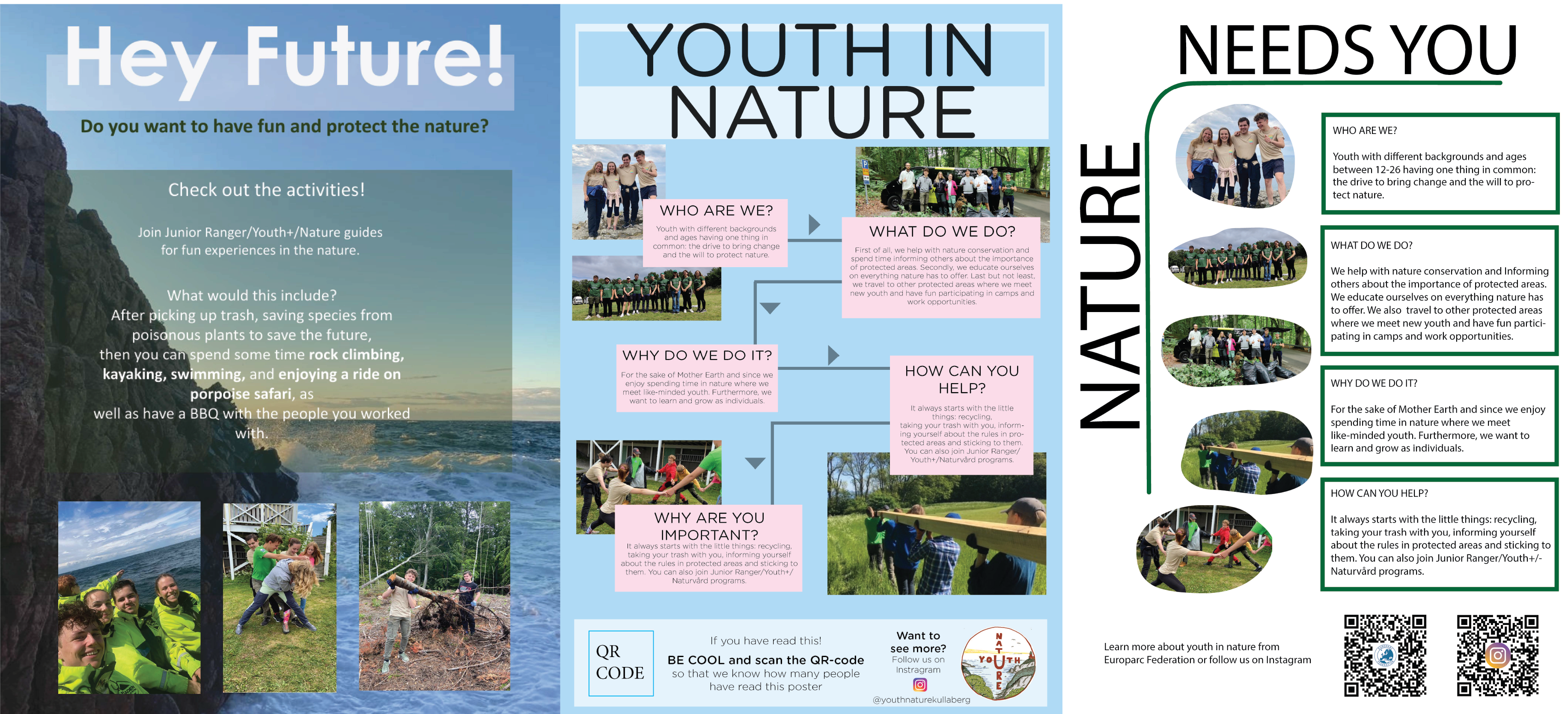
Advertising youth engagement in Kullaberg Nature Reserve
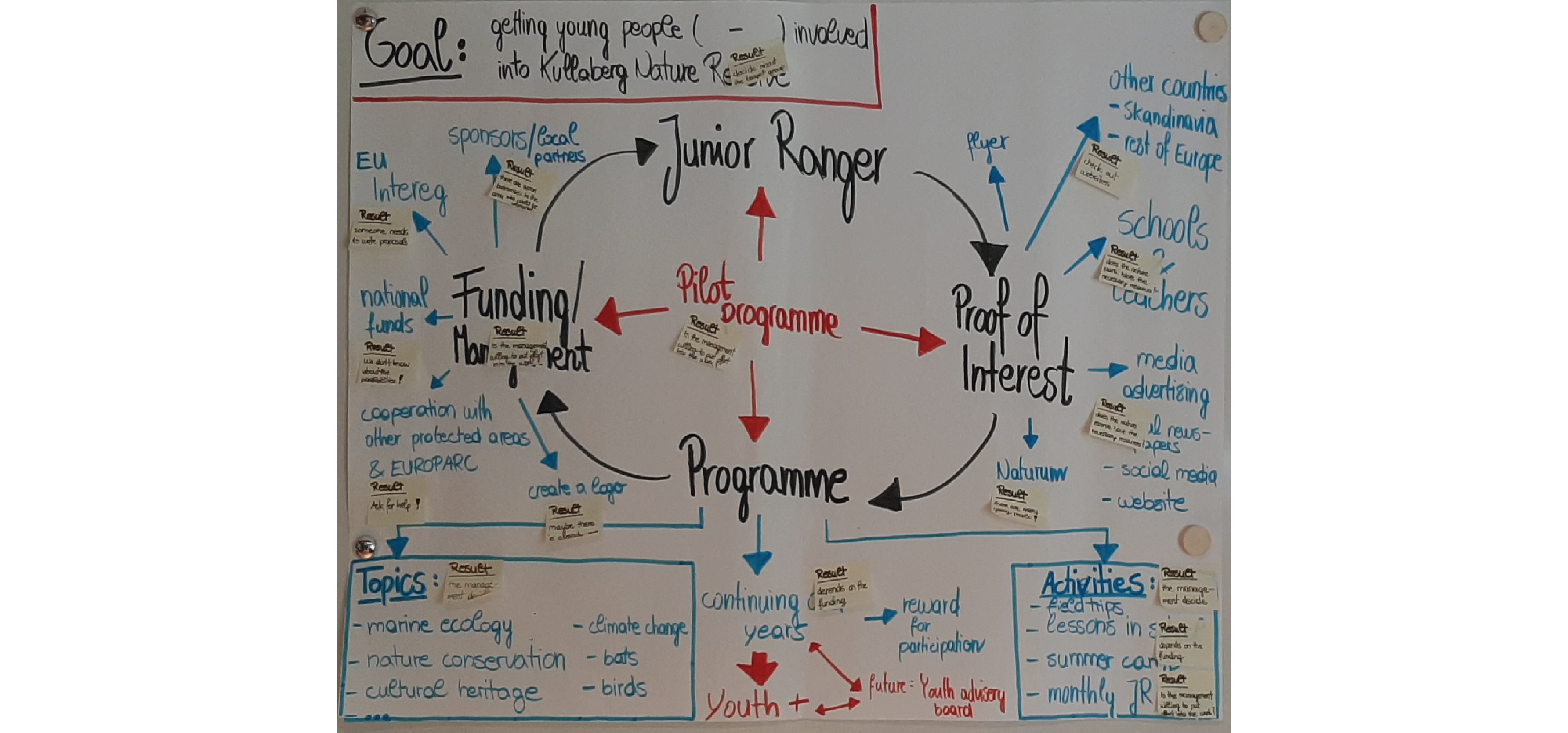
A diagram of the youth involvement process at Kullaberg Nature Reserve
At the end of the three weeks, each of the Youth+ participants prepared a presentation of their home Protected Areain which they had already gained experience. The local staff, Youth+ and Junior Rangers were excited to hear how other Protected Areas were running their Junior Ranger and Youth+ programmes. The audience was eager to travel and experience this first-hand, and plans were made to travel together.
In addition to the insights into the work of the Protected Area, there was also time to get to know Sweden better. Some participants visited Gothenburg, Lund, Malmö, Helsingborg and thanks to the proximity to Denmark also Helsingør. Not only cities, but also the other nature reserves of southern Sweden were explored. The notorious bathing culture became a social event during the early morning swim. To recover from the cold of the sea, the sauna in the accommodation was heated up several times in the evening. The participants also used their free time to better explore the surrounding area. Lonely bays, breathtaking sunsets and jumping tunas were among the absolute highlights here. Barbecue evenings, cooking together (seaweed pasta, köttbullar and much more), a crayfish party, movie nights and karaoke swore the participants together to a team and made the time in Sweden fly by and new friendships developed. Nobody will forget this great time so quickly!
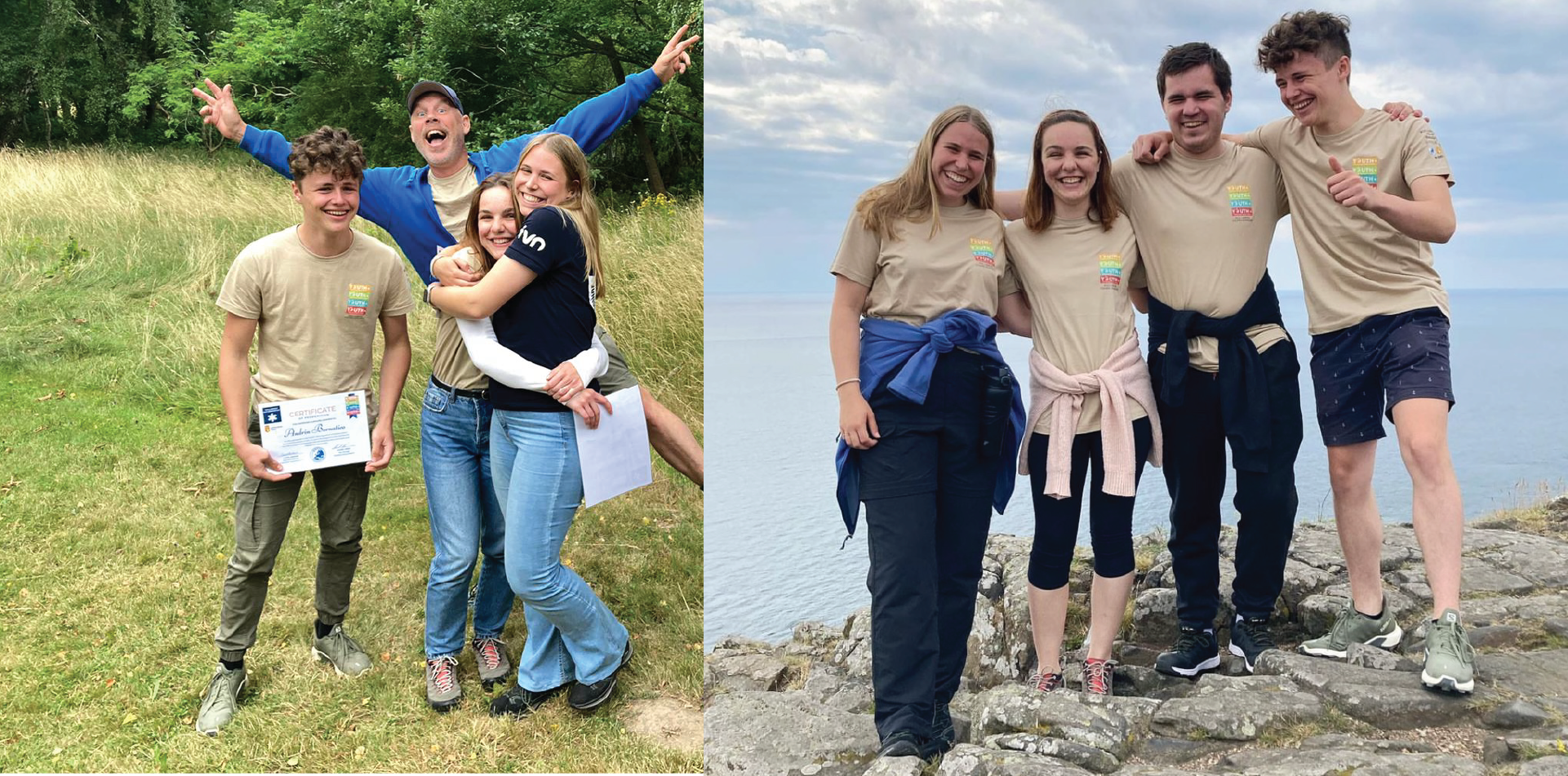
The first group: Silke Peters (NL), Manja Jakopič (SI), Krišs Atvars Saberovs (LV), and Andrin Bornatico (CH)
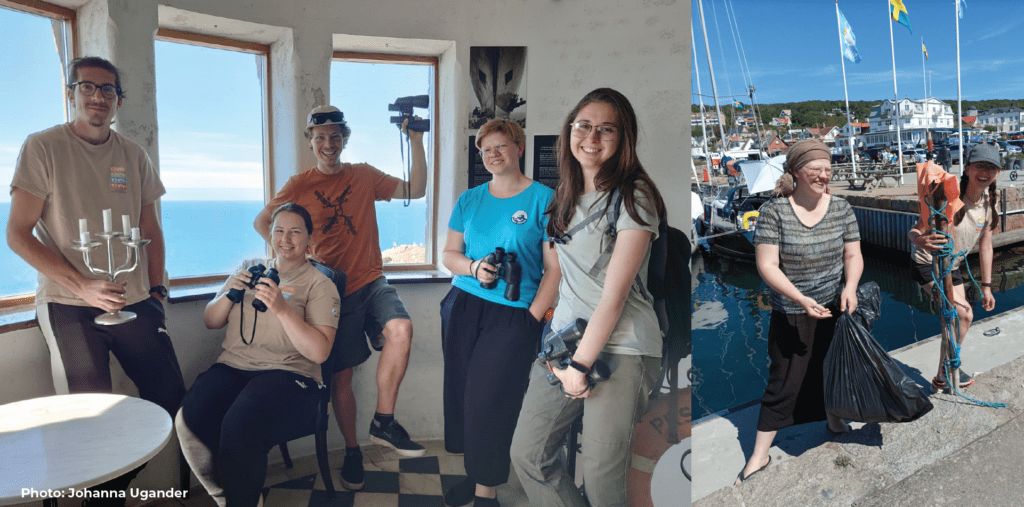
The second group: Alberto Madrassi (IT), Irina Guljavina (EE), Moritz Mairl (IT/AT), Mari Roose (EE), and Judit Márquez Pérez (ES),
This work was supported by:

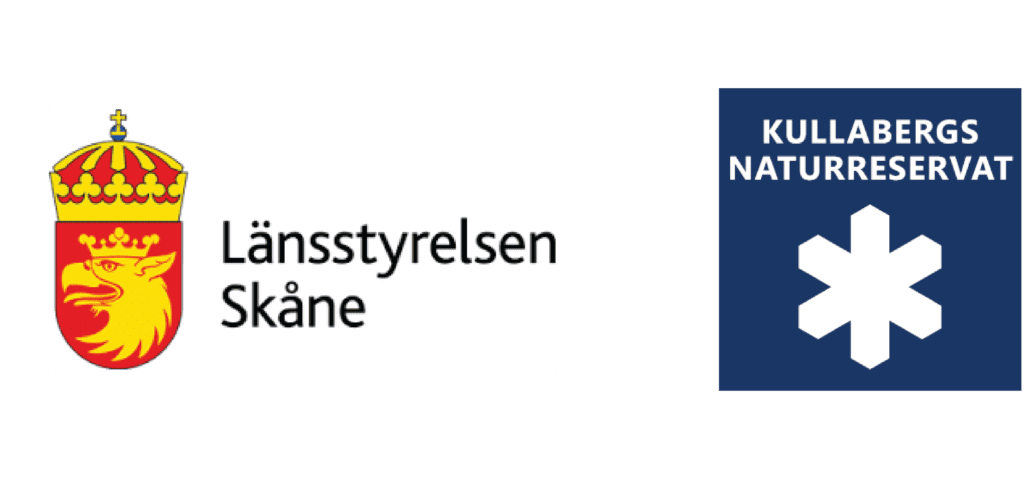
EUROPARC Webinar, 3.11: Conflict management through participatory processes
We invite you to the next EUROPARC webinar “Conflict management through participatory processes: How Protected Areas can build partnerships with local stakeholders”.
- 3.11.
- 14:00 – 15:00 CET
- Free, but registration is mandatory
The webinar
Collaborations with local stakeholders are key objectives for Protected Area managers. Through dialogue, reciprocal listening and mutual understanding, conflicts can be mitigated.
In this webinar, we will hear from two experts on the creation and implementation of local platforms. These platforms, made up of local authorities, hunters, shepherds, farmers, scientists, and citizens, work on the coexistence between humans and large carnivores.
Furthermore, we will discuss with participants how some of these ‘lessons learned’ can be useful in other participatory processes and how they can possibly be adapted and replicated in the practices of different Parks.
This webinar will focus on participatory processes, and is aimed at Protected Areas managers working on dialoguing and building partnership with farmers and breeders, but also with tourism business and other local stakeholders.
Contributions and experiences from participants to be shared in the debate are welcomed!
The Programme
Welcome and Introduction
Stefania Petrosillo, Policy Officer at EUROPARC Federation
The regional platform projects on large carnivores: what works and what doesn’t
Valeria Salvatori, The Institute of Applied Ecology
Facilitating multi-level stakeholder platforms: the example of Sweden
Bernard Le Roux, Dialogues Facilitation Gothenburg AB
Q&A
Discussion with Participants
The Speakers
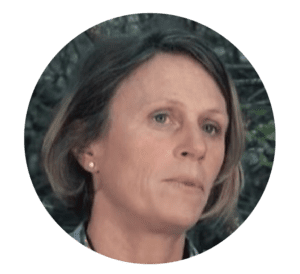
Valeria Salvatori
Valeria is councillor and secretary of The Institute of Applied Ecology (IT).
Wildlife research and management are her main interests. She is active in the area of large carnivore management, is a member of the IUCN LCIE-Large Carnivore Initiative for Europe, and has directed several LIFE projects targeting wolves and bears. She has interacted with hunters, foresters, livestock breeders, shepherds, farmers, scientists, and citizens in areas where wildlife species of particular interest such as large carnivores are present.
Since 2017 she manages the project “Establishment of local stakeholder platforms on large carnivores”, a EC funded project for the establishment of participatory processes on large carnivore management in high conflict areas in Europe. She is an active member of the EU Platform on Coexistence between People and Large Carnivores.
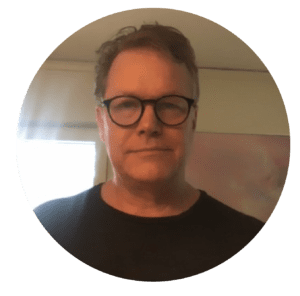 Bernard Le Roux
Bernard Le Roux
Bernard is a facilitator, mediator, and co-founder of Dialogues Facilitation Gothenburg AB (SE).
He devotes his working time to developing and refining ways in which conflicts and tension can be transformed into growth and development for individuals, groups and society through dialogue. He believes in the power of honest and open dialogue to move beyond fixed positions as a way to avoid destructive conflict. Living in Sweden, he works with local and regional authorities, the Swedish Environmental Protection Agency, Forestry Service and Counties, the Peace Education Institute in Helsinki, and the Swedish Association of Municipalities and Regions. He also works with mediation policy and training in Colombia and teaches at the School of Collective Intelligence in Morocco. He is supporting the project “Establishment of local stakeholder platforms on large carnivores” and the EU Platform on Coexistence between People and Large Carnivores.
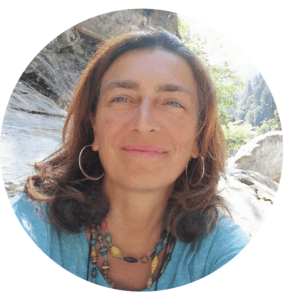 Stefania Petrosillo
Stefania Petrosillo
Stefania is EUROPARC’s Policy Officer in Brussels.
In her role, she represents EUROPARC member’s interests towards the European Institutions. Stefania is an expert in advocacy and policy, and works in close cooperation with international NGOs and other EUROPARC partners. She has a long experience in international cooperation in EU and non-EU countries. In Brussels, she follows in particular the debates about the Common Agriculture Policy, and supports EUROPARC’s Commission on Agriculture and Protected Areas.

Puri Canals: Alfred Toeper Medal winner 2022!
Yearly, EUROPARC awards the Alfred Toepfer Medal to those who have made significant contributions to nature conservation.
The Medal
The Alfred Toepfer Medal is named after the “founding father” of EUROPARC: Dr h.c. Alfred Toepfer. Individuals, that have made a significant contribution to nature conservation through a lifelong body of work are recognised with the Medal. The medal is awarded by peers: it are the EUROPARC members that can nominate someone. The EUROPARC Council then internally votes on the winner.
Purificació Canals i Ventín
Transboundary Parks awarded 2020-2022
Due to a COVID-19 forced break, EUROPARC could not recognise the Transboundary Parks that joined the network in 2020. However, at the award Ceremonies during our Conferences in France and Austria in 2021 we could put the spotlight on the 10 Parks that (re)joined!
In EUROPARC we like to recognise the great work being done, managing our Protected Areas around Europe. After two years, we were finally able to award the Transboundary Parks that joined the network, or renewed their commitment.
Háldi Transboundary Area
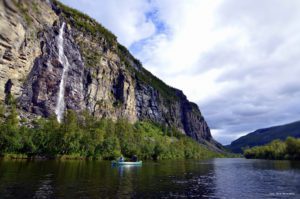
Reisa National Park- Ph. R. Benonisen
This area newly joined the TransParcNet”! It is a cooperation between the Finnish and Norwegian Park managers and unites the Käsivarsi Wilderness Area, Reisa National Park and Ráisduottarháldi Protected Landscape. Their verifier states:
Háldi Transboundary Cooperation Area is a contiguous wilderness area, managed in good cooperation to preserve high natural, cultural and recreational values of the most arctic area of continental Europe and in the heart of the Sami Homeland.
You can learn all about them here.
Internationaler Naturpark Bourtanger Moor – Bargerveen
Internationaler Naturpark Bourtanger Moor – Veenland is a unique bog ecosystem. The largest contiguous raised bog in Europe once reached from northwest Germany all the way into the Netherlands. After extensive destruction of the moor towards the end of the last millennium, the cross-border nature park has set itself the task of protecting and developing the remains of this fascinating habitat. But not only the moor areas with their magnificent bird life are waiting to be discovered. Likewise, picturesque river landscapes, purple blooming heather areas and old pastoral forests belong to the very special protected areas of the int. Naturpark Bourtanger Moor – Veenland.
Learn more about the Park here.
Scarpe-Escaut Plain European Nature Park
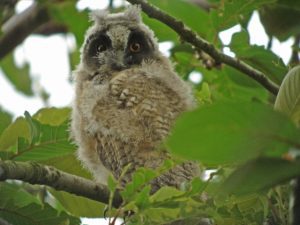
Owl at Scarpe Escaut, by Moyen Duc.
This Park, which shares a border with France and Belgium brings together the Scarpe-Escaut Regional Nature Park (PNRSE in France) and the Escaut Plains Nature Park (PNPE in Belgium). This territory has maintained a rural and natural character with many meadows, forests and wetlands, but is under pressure from the surrounding urban areas. At the intersection of major urban poles (Lille metropolis, Valencian, Douaisian and Tournaisian poles), its high population density, its industrial, mining, and natural heritage make it an atypical territory.
Learn more about the Park here.
Renewed commitment
Furthermore, the following areas renewed their commitment to this Transboundary network:
- Transboundary Area Julian Alps (IT/SI)
- Bavarian Forest & Šumava National Parks (DE/CZ)
- Krkonoše & Karkonosze National Parks (CZ/PL)
- Podyjí & Thayatal National Parks (CZ/AT)
- Neusiedler See – Seewinkel & Fertö-Hansag National Parks (AU/HU)
- Maas-Schwalm-Nette Nature Park (DE/NL)
- Saxon-Bohemian Switzerland Transboundary Areas (DE/CZ)
We congratulate all these Parks and thank them for their continued dedication to this EUROPARC Programme!